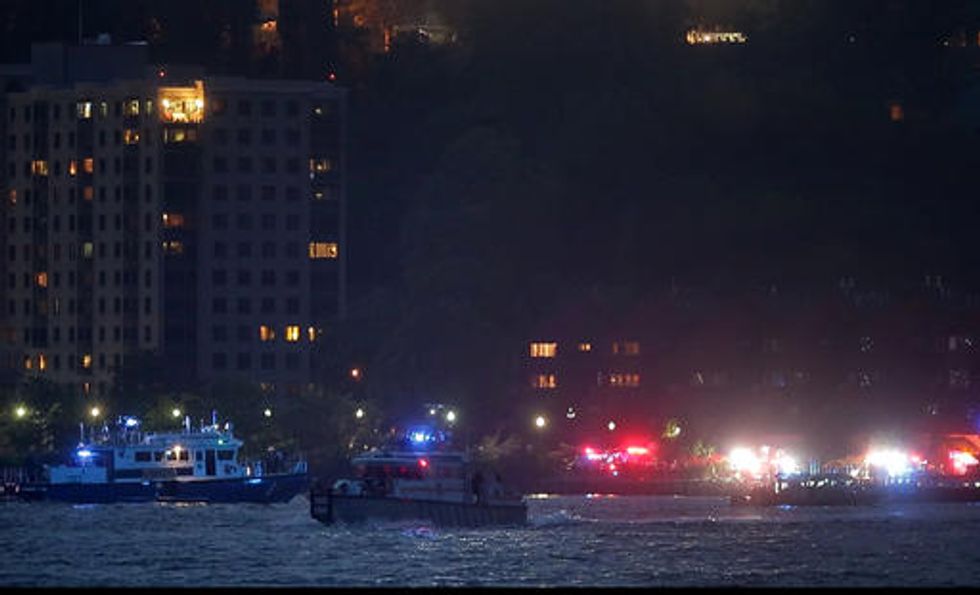
© 2025 Blaze Media LLC. All rights reserved.
The plane was kept at the museum and was taking part in a Memorial Day air show this weekend.
UPDATE 9:30 a.m. ET Saturday:The veteran air show performer who died when a World War II plane crashed into the Hudson River between New York and New Jersey is being hailed as an "extraordinary pilot."
Scott Clyman of the American Airpower Museum said in a statement Saturday that Bill Gordon understood the "powerful message" that historic aircraft represent "in telling the story of American courage and valor."
Clyman says Gordon "was a nationally respected pilot."
NEW YORK (TheBlaze/AP) — A small World War II vintage plane taking part in celebrations of its 75th anniversary flew a partial loop while smoke spewed from it and then crashed in the Hudson River between New York and New Jersey on Friday, and divers recovered a body from its sunken wreckage, police and witnesses said.
The single-seat plane, a P-47 Thunderbolt, flew periodically, including to air shows. A witness to the crash, Hunter College student Siqi Li, saw smoke spewing from the plane and thought it was doing a trick.

"It made kind of a U-turn, and then there was a stream of smoke coming from it," Li told the Daily News. "It was tilting down toward the water. I thought they were doing some sort of trick. I didn't realize it at first, but it was a plane crash."
Scuba divers recovered the body of a 56-year-old man from the submerged plane about three hours later, New York Police Department Detective Michael Debonis said. Police identified the body as William Gordon, of Key West, Florida.
Gordon's body was taken back to the New York shore via police boat. Several police officers carried a stretcher to the dock.
The Federal Aviation Administration said the P-47 Thunderbolt aircraft, which went down near the George Washington Bridge around 7:30 p.m., was among three planes that had departed from Republic Airport in Farmingdale, on Long Island, just east of New York City. The other two aircraft returned to the airport and landed safely.
The American Airpower Museum is celebrating the 75th anniversary of the P-47 Thunderbolt this weekend. Museum spokesman Gary Lewi said the plane was kept at the museum and was taking part in an air show at nearby Jones Beach this weekend.
"Apparently the aircraft suffered an inflight engine failure," Lewi said. "I'm told the aircraft is at the bottom of the Hudson."
The three planes, the P-47, a P-40 and a photo plane, had been flying over the Hudson to shoot promotional material for the Jones Beach air show, Lewi said.

North Hudson Regional Fire and Rescue co-director Jeff Welz told The Jersey Journal that firefighters and the Coast Guard responded after the Friday night crash. He said the plane sank "pretty quickly."
The P47-Thunderbolts were the heaviest single-engine fighter planes used by Allied forces in World War II. They first went into service in 1942, with the 56th Fighter Group based on Long Island.
Friday's crash occurred on a part of the river near where a US Airways commercial jet carrying 155 people splash-landed safely in 2009 in what became known as the Miracle on the Hudson. The plane's pilot, Captain Chesley "Sully" Sullenberger, became a household name after the incident.
Want to leave a tip?
We answer to you. Help keep our content free of advertisers and big tech censorship by leaving a tip today.
Want to join the conversation?
Already a subscriber?
more stories
Sign up for the Blaze newsletter
By signing up, you agree to our Privacy Policy and Terms of Use, and agree to receive content that may sometimes include advertisements. You may opt out at any time.
Related Content
© 2025 Blaze Media LLC. All rights reserved.
Get the stories that matter most delivered directly to your inbox.
By signing up, you agree to our Privacy Policy and Terms of Use, and agree to receive content that may sometimes include advertisements. You may opt out at any time.





